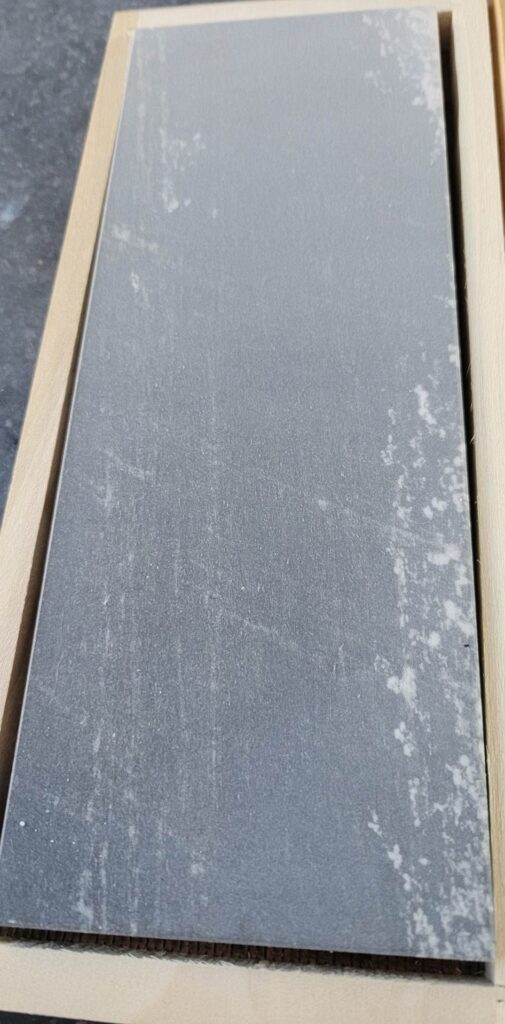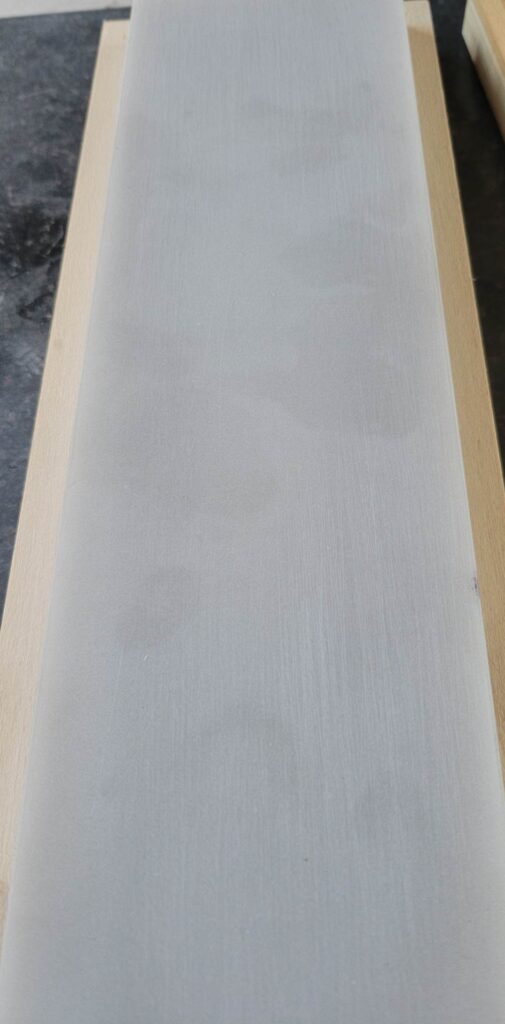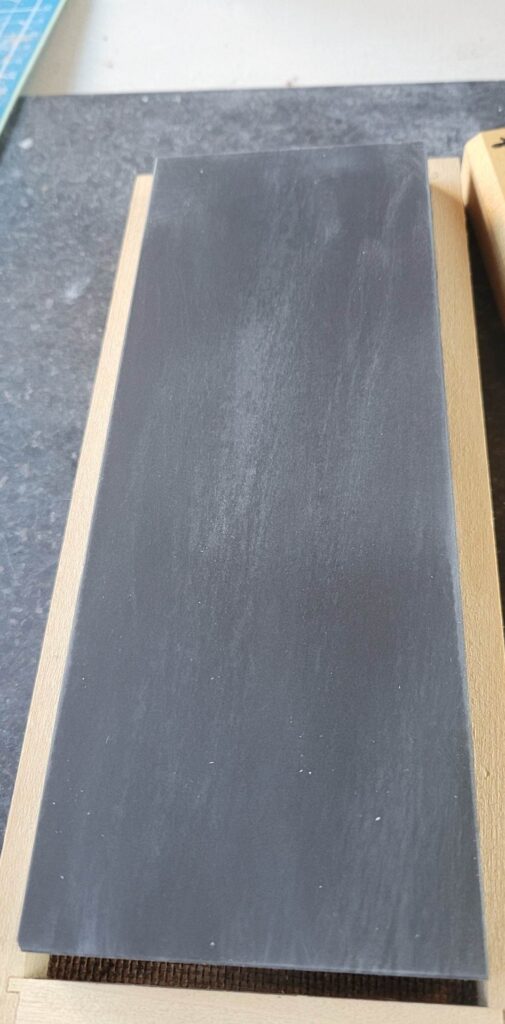Arkansas whetstones come from Arkansas, USA and are very popular with woodworkers around the world. They originate from the small Ozark mountainous region east of the hot springs in Arkansas first sold by the Pike company who would go on to become Norton. In reality, Washita and Arkansas whetstones are mined from different quarries but are functionally similar in composition and as such often grouped together.
These stones are often called oilstones, though they work quite well with just water. When less stones were available to the average public, the use of oil was more common to allow it to be smoother than its natural grain by reducing the friction and creating cushion between the blade and the abrasive particles. Now it comes down to personal preference as the finest Arkansas stones can do everything you need with water and proper surface conditioning. I do not use oil on any of my stones given the difficulty of removing it should you want to. There are also some old instructions which discuss using the stone without oil or water and dry honing on it at the end. This can be interesting to experiment with.
Arkansas/Washita stones are claimed to be close to pure silica, or around 99.5%. This makes them an extremely pure novaculite stone with fine hard grain patterns. The Washita mine was more efficient than the Arkansas mine, producing 50% usable content rather than the 25% that came from the Arkansas.
From each mine came variants of the stone with their own unique name. These are useful when looking for stones to identify how the stone will perform and which you prefer. One of the key differences between Washita and Arkansas stones is that Washita are no longer mined w here as the Arkansas stones are. This makes some of the Washitas more difficult to get. There is plenty of Washita stone left in the ground should Norton want to restart production (as they did briefly in the early 2000s), but as of now it continues to be inactive.
Sections
Using Arkansas / Washita Stones
Arkansas Grit Rating
Washita Oilstones
Soft Arkansas
Hard Arkansas
True Hard Arkansas
Hard Black Arkansas
Translucent Arkansas and Surgical Black Arkansas
Further Information
Using Arkansas Whetstones
Unlike some other natural whetstones, Arkansas stones do not tend to respond well to the formation of “slurry” on their surface from the base stone. They are best used with the surface conditioned to a level you want the stone to cut at. This technique is where you flatten the surface of the stone using SIC powder or a diamond plate to the level of desired fineness and let the surface of the stone do the majority of the cutting. For instance, a Translucent Arkansas will be a very aggressive stone if the surface is conditioned to 140 grit, whereas if the surface is conditioned at 10000 grit it will be very slow and able to do razors. The internal grit of the Arkansas stone at all levels is rather aggressive though, so once you form a slurry you will find the stone incompatible with very fine jobs until the surface is reconditioned again to the desired level of fineness. This does not stop someone from forming a slurry on the surface of the stone which does not originate from the base stone – E.G. using a slurry stone or Nagura from a different stone origin. Great results have been reported using JNAT Nagura or Tam O Shanter slurry stones on Arkansas stones.
Arkansas and Washita stones can be used with water or oil but are traditionally used as oilstones. Per the method of focusing on surface conditioning, the oil allows you to get the stone to act even finer than usual for the stones conditioned level. If you are looking for a finer level of sharpening/honing and do not wish to use oil, running water is a viable but not as effective substitute.
Arkansas Whetstones Grit Rating and Differences
As discussed in other pages on the website, natural stones don’t really have assigned grit ratings as they are not formed like synthetic stones are formed. However, often people want to get an idea of how the stone will perform before they add one to their collection and giving an analogous grit rating can help someone compare an unknown to their own frame of reference. Unlike other natural stones though, the Arkansas are particularly hard to do this with.
This is for two reasons, the first being how the stone is actually formed. Arkansas and certain other novaculite (not all though) are formed in what we call a “matrix”. This is where rather than having a clay-like or mud-like binder containing abrasive grit – the whole stone is functionally the crystalline grit material such as quartz or silica. In such a case, we would probably say an Arkansas stone has grit the size of 10 microns and would be about an 800-1000 grit stone if it was accurate to go off of that alone and corresponds to the slurred grit you see in each of the sections below. Instead, we grade the Arkansas stones by specific gravity, which is indicating how compacted the stone has become during its formation. The more compact it has become, the more tightly the crystals are formed together. This does not correspond to grit, but it does impact how it is used. However, since the stone itself is entirely comprised of the abrasive material it does not get graded or function even remotely similar to other stones.
Related to that matrix formation, the second reason it is difficult is because Arkansas stone use revolves more heavily around surface conditioning than any other natural stone out there besides maybe a Cretan Stone. The higher the specific gravity of the stone, the more compact the crystals within the stone have been formed, and thus the farther we can take the surface with surface conditioning. This does not mean we lowered the micron size of the imbedded quartz, but it does impact how smooth the surface can get. These two elements play together to make non-slurry grit of Arkansas stones incredibly difficult to functionally express and the best we can do is give an approximation of similar functionality.
Due to this and in an effort to paint the best picture I possibly can of the stones, I will put an analogous slurry grit rating as well as an analogous upper end conditioned rating. It will be evident that with slurry all of the stones begin to act fairly aggressively, but that they reach different levels of conditioned fineness and as such create a form of progression amongst themselves (though you would not move through them as steps like a JNAT stone).
You will also notice I put the cap at 8000+. Many will say the higher-level ones can do 12k+ analogous grit rating, but it is a hotly debated topic within the community of people who use these stones. This is mainly because the line between cutting and burnishing (where the stone no longer is cutting) is hard to quantify. Anything at or above 8k can finish a razor, and from there unique qualities of the stone come into play and you have to find for yourself what you like (whether the stone is polishing or burnishing is irrelevant at that point).
The last thing to consider is that all Arkansas stones are slow. Even if the analogous grit is low, all of them are very hard and very slow relative to most other natural whetstones. The ranges with slurry give you an idea of how deep the worst scratches are and not a clear idea of how fast the stone will really cut. Out of almost all the natural stone lineups across all regions, Arkansas will be some of the slowest out there for their ascribed grit rating. This does not mean they are bad, and often can be a boon for people who want gradual control but it is worth considering that a “1000 analogous grit” Arkansas stone will cut drastically different and slower than a “1000 analogous grit” JNAT.
Washita Oilstones
Information on Washita Oilstones can be found here. Generally, Washita stones will be more consistent grit and porousness to them resulting in faster cutting than the majority of Soft Arkansas stones. There is however significant overlap in the performance of “Fine” Washitas and “Soft” Arkansas stones – thus it is possible to find a Soft Arkansas which can cut faster than a “Fine” Washita.
Soft Arkansas Whetstones
Though called soft, the stone is not a literally “soft” stone like a JNAT or certain slate can be. It is called soft as it contains has a less compact particulate density than the other stones. This means that the surface is more porous and thus “softer” as well as that the particles have been compressed less and are often at a microscopic level larger and thus not as fine. This stone is usually what we would consider medium grain, better utilized for tools and bevel setting. This will pull metal the fastest of all the Arkansas stones. It is the most popular and price efficient version.
Analogous Slurry Grit: 600-800
Analogous “Upper End Conditioned” Grit Rating: 6000-7000
Specific Gravity: 2.25-2.30
Hard Arkansas and True Hard Arkansas Whetstones
This is where things start getting tricky when it comes to Arkansas stones. Originally, there were only two versions of Arkansas stones – soft and hard. As time has gone on, the style of stones has been further organized into different names and can make for some confusing overlap. Originally, Hard/True Hard/Black Hard/Surgical Black/Translucent stones were all sold as “Hard Arkansas”.
To further obfuscate things, some stone producers identify a tier called “True Hard” while others do not have such a tier of stone. If you are buying from a vendor who delineates between “Hard” and “True Hard”, they are functionally labelling stones which normally would have been “harder/fine” Soft Arkansas stones as Hard Arkansas, than turning what would previously have been called Hard Arkansas stones into True Hard Arkansas stones. To my understanding, Dans Whetstones is the stone producer who started this, and this comes up the most with.
Other stone producers do not usually have a difference between “Hard” and “True Hard”, and it is likely that their “Hard” is analogous to “True Hard”. Some people like Dan’s grading system as it probably makes it clearer you will get a stone like an “old Hard Arkansas” stone if you buy the True Hard variant, others think it’s about maximizing stone prices. As long as you understand what the situation is, it isn’t an issue either way really.
Analogous Slurry Grit: 800-1000
Analogous “Upper End Conditioned” Grit Rating: 6000-7000 or 8000+
Specific Gravity: 2.30-2.45 or 2.50+
Hard Black Arkansas Whetstones
Functionally a version of “True Hard” or actual “Hard” stones which are deep black. For whatever reason this does not maintain the name “True Hard” when sold by Dans Whetstones even though it functionally is one by their own delineations. The stone is in line with the True Hard and Translucent styles in use. Hard Black is not the same as “Surgical Black” and is a topic of frequent debate. When compared side by side, this will be a deep dark black whereas the Surgical will be more of a Translucent Hazy black. Some will claim that the Translucent or Surgical Black varieties are above the performance levels of Hard Black and if there is any truth to that it is at such a small level, I would probably say it comes out in the wash due to stone to stone variance.
Analogous Slurry Grit: 800-1000
Analogous “Upper End Conditioned” Grit Rating: 8000+
Specific Gravity: 2.50+
Translucent Arkansas and Surgical Black Arkansas Whetstones
A color variation of True Hard which results in a uniform translucent shade of gray, white, yellow, brown, black, or pink. Surgical Black is the name for the Black Variant and is often sought after and sometimes claimed to be the keenest of the Translucent options though not a lot of proof exists for this. In general, these are considered superior to the True Hard Arkansas because they are essentially an extremely uniform version of True Hard. A nice True Hard stone will functionally perform the same though, but you will get no “duds” with Translucent or Surgical Black varieties.
A less grounded reason these may be considered “better” than Hard Black or True Hard is because Translucent and Surgical Black have always been more expensive historically. This comes from the layer being thinner and more brittle than the more mixed “Hard Black” layer – resulting in more failed stone cuttings – and less stones available to sell thus increasing the price. However, this rarity still makes them desirable even if you consider they may perform the same.
Analogous Slurry Grit: 800-1000
Analogous “Upper End Conditioned” Grit Rating: 8000+
Specific Gravity: 2.50+



